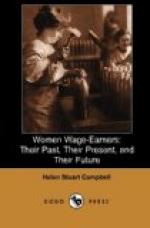Passing to Germany, a good two-thirds of the women are at work in field or shop or home, the proportion of women in agriculture being larger than in any other country of Europe. Her schools furnish better training than those of any other nation. In all these points Prussia leads, though till recently legislation has been in behalf of child-workers, and women have been practically ignored. But factory regulations are minute and extended; and the questions involved in the labor of women, and its bearing on health, longevity, etc., are now coming under consideration. In Silesia, as early as 1868, women were excluded from the salt-mines; and the Labor Congress of 1889 brought about many changes of the laws on this point for Belgium and Germany. In Italy, in which country industrial education is now receiving much attention, the labor of women, continuous, severe, and underpaid, as it is known to be, finds small mention, save among special students of social questions. Russia has practically no data from which judgment can be formed. In short, it is only in English-speaking countries that really efficient action as to the labor of women has taken place; while even for them the work has but begun, and new and more radical forms will be necessary for any real progress toward final betterment. Toward such end the labor bureaus of our own country are working diligently; and it is with them that we have next to do, the investigations already made and incorporated in their reports being full of suggestion for future workers.
The census of 1882 gave for Germany, in a population of 45,222,113 persons, 23,071,364 women, of whom 1,109,530 were widows, and 5,467,730 unmarried, a large proportion of both these classes being self-supporting. An immense number of these were agricultural laborers. In Prussia in 1867 the census gave the number of women agricultural laborers as 1,054,213. Woman’s wage for a day’s labor, always twelve and often fourteen hours, is from twenty to twenty-five cents, about a third of that received by men doing the same work. Brassey, the great railroad contractor, found throughout Germany that her wage was always a third and often a quarter less than that of men.
For united Germany the description given by Villerme in 1836 is still true for many points. “The misery in which the cotton spinners and weavers of the upper Rhine live,” he writes, “is so profound that it produces the saddest results. In the families of manufacturers, drapers, merchants, etc., half the children born attain their nineteenth year, this same half ceasing to exist before the age of two years in the families of weavers and workers at cotton-spinning.”




